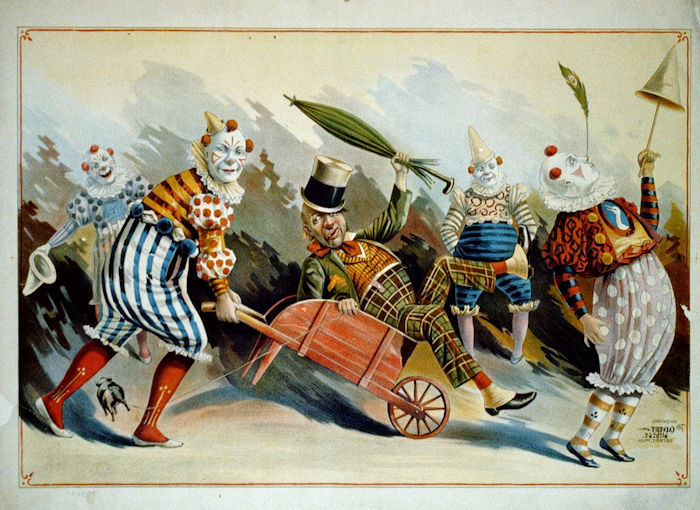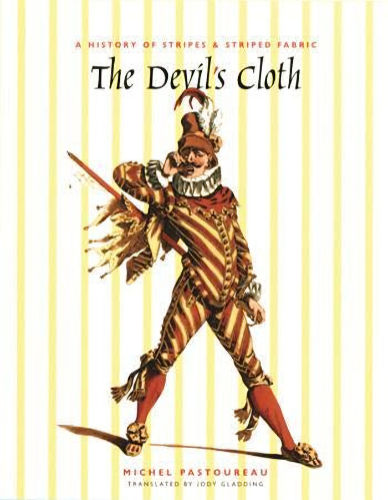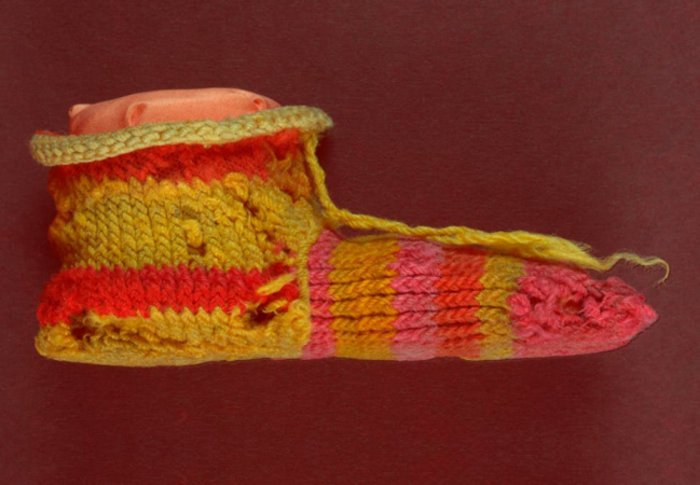Conny Waters – AncientPages.com – Striped clothing is common today, and most people have some fabrics with this pattern in their wardrobe. However, the history behind striped clothing is dark and sinister. During the Middle Ages, one could be given a death sentence just for being dressed in stripes!
Medieval people considered stripes the Devil’s cloth. If you saw someone wearing stripes, it was a sign of an outcast or someone who needed to be contained. If you study Medieval paintings, you can observe the Devil himself is often depicted wearing stripes.

Five Circus Clowns. Credit: Library of Congress Prints and PH๏τographs Division – Public Domain
“In the medieval Western world, there are a great number of individuals – real or imaginary -whom society, literature, and iconography endow with striped clothing. In one way or another, they are all outcasts or reprobates, from the Jew and the heretic to the clown and the juggler, and including not only the leper, the hangman, and the prosтιтute but also the disloyal knight of the Round Table, the madman of the Book Psalms, and the character of Judas. They all disturb or pervert the established order; they all have more or less to do with the Devil.” 1
Historians think the hatred toward stripes may be related to a pᴀssage found in the Third Book of Moses, commonly called Leviticus.
“You must not wear clothing made with wool and linen meshed together.” (Leviticus 19:19)
No one was safe from the dangers of wearing stripes, not even monastic orders. For example, the Carmelite Order, founded in the 12th century on Mount Carmel in the Crusader States, caused a scandal because its members wore a “cloak striped with four white bands representing the four cardinal virtues (strength, justice, prudence, and temperance).” 1
When the Carmelites arrived in Paris, they became victims of mockery and abuse from the populace. People shouted horrible insults and showed no respect toward the religious representatives. The same happened to the Carmelites in England and Italy. Sometimes, when verbal abuse was not enough, angry mobs attacked the monks. Cases of physical abuse against the Carmelites were reported. The members of the order were also accused of “greed, hypocrisy, and treachery.” 1 The Carmelites were seen as henchmen for the Devil and the Anti-Christ.
It should not be surprising to learn that after the General Chapter of the Order of 1287 in Montpellier, France. The Carmelites replaced the white and brown striped cloak.
Once in a while, some bold individuals tried to fight against the stripe clothing prejudice, but often they ended up either in prison or were sentenced to death. In 1310, a French shoemaker started dressing in striped clothes, and it did not take long before he was arrested, sent to prison, and convicted to death.

“To stripe a surface serves to distinguish it, to point it out, to oppose it or ᴀssociate it with another surface, and thus to classify it, to keep an eye on it, to verify it, even to censor it.
Throughout the ages, the stripe has made its mark in mysterious ways. From prisoners’ uniforms to tailored suits, a street sign to a set of sheets, Pablo Picᴀsso to Saint Joseph, stripes have always made a bold statement. But the boundary that separates the good stripe from the bad is often blurred. Why, for instance, were stripes ᴀssociated with the Devil during the Middle Ages?
How did stripes come to symbolize freedom and unity after the American and French revolutions? When did the stripe become a standard in men’s fashion? “In the stripe,” writes author Michel Pastoureau, “there is something that resists enclosure within systems.” So before putting on that necktie or waving your country’s flag, look to The Devil’s Cloth for a colorful history of the stripe in all its variety, controversy, and connotation.” Read more:
By the 13th century, the bias against stripes was well entrenched in Europe’s sumptuary laws. Depictions of disreputable men and slutty women wearing stripes to signal their outsider status emerged.
Stripes were a humiliation which is why certain types of citizens, such as prisoners, wore this pattern.
As time pᴀssed, the atтιтude toward striped cloth changed, but it was a pattern people ridiculed, and clowns were dressed in stripes.
Stripes are accepted in modern society, but prejudice has never really died.
“This connotation of striped cloth is with us still; a jumpsuit or a tunic-and-trousers combination garment made of broadly striped cloth, in either horizontal or vertical stripes, instantly carries the ᴀssociation of prisoners, convicted criminals, or, in a tragic variation, inmates of concentration camps.
A loose, lightweight pajama-like union suit of brightly striped cloth, with a broad collar and cuffs, is the iconic outfit of the clown, a figure whose humor derives from his license to transgress the boundaries of orderly society.” 2
Nevertheless, we cannot ignore that “in the last two centuries, stripes have also taken on new, positive meanings, connoting freedom, youth, playfulness, and pleasure. Witness the revolutionary stripes on the French and United States flags.”1
It should be noted that while the Medieval Western world despised stripes, this pattern was popular in other parts of the world.

A stripy child’s sock dating from 300AD, was found in a rubbish dump in Egypt. PH๏τograph: The British Museum
Ancient Egyptians liked stripy socks. Whether they invented them cannot be said with certainty, but they were undoubtedly one of the earliest civilizations that wore stripy socks.
“We know this because researchers at the British Museum have analyzed a sock that once belonged to an Egyptian child. The sock dated to about 300 A.D. and was recovered from a rubbish dump in ancient Antinoupolis in Roman Egypt.” 3
Written by Conny Waters – AncientPages.com Staff Writer
Copyright © AncientPages.com All rights reserved. This material may not be published, broadcast, rewritten or redistributed in whole or part without the express written permission of AncientPages.com
Expand for references
- Michel Pastoureau – The Devil’s Cloth: A History of Stripes & Striped Fabric
- John S. Major – Striped Cloth, Love To Know
- Conny Waters – Ancient Egyptians Used Stripy Socks And May Have Invented Them, AncientPages.com
- Mark Hampshire – Stripes (Communicating With Patterns S.)





